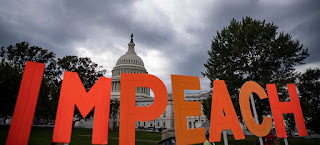
When the House acted swiftly to impeach Donald Trump for a second time on Jan. 13, the actual Articles of Impeachment were shockingly brief. With just five pages, the first of which is completely taken up with the names of sponsors who signed onto the resolution, the gist of the single article is that Trump repeatedly issued false statements that inflamed the crowd and incited insurgents on Jan. 6. The statements cited in the resolution include Trump’s oft-repeated claim that “we won this election, and we won it by a landslide” and more aggressive statements like “if you don’t fight like hell, you’re not going to have a country anymore.”
Those statements, which Trump repeated at the rally he held shortly before the insurgents swarmed up the steps of the Capitol, may seem scant. And arguments over whether they are really incitement to violence may seem to allow Republicans a lot of wiggle room when it comes to their vote.
But the article is not everything that House members will be bringing to the Senate when they come for Trump’s trial on Feb. 8.
In addition to the article itself, there are considerably more detailed supporting documents. These documents don’t just cite the statements that Trump made on the morning of the assault on the Capitol, they cover the whole period following the election and show how Trump laid the groundwork for violence. That means that things like the phone call Trump made to Georgia Secretary of State Brad Raffensperger, and tweets that Trump put out threatening any officials who got in his way, are fully covered.
The document also details events on Jan. 6, including statements by Rudy Giuliani urging the crowd to have “have trial by combat,” and Donald Trump, Jr. warning Congress that “we’re coming for you.” And it points out how, when Trump got up to speak, he called out specific legislators as targets for the crowd’s hate before falsely telling them that he was going to walk up Pennsylvania Ave. with them.
The document is far from comprehensive. It doesn’t contain a full list of the 62 legal actions filed by Trump’s team. It doesn’t cover all the changes Trump made at the Pentagon following the election. It doesn’t discuss the scheme to sub in a Devin Nunes aide as head of the CIA. It doesn’t cover Michael Flynn’s plan to implement “partial martial law” or DOJ attorney Jeffrey Clark’s scheme to use the Justice Department to interfere in counting the electoral vote.
But there is more than enough in the provided documents to show that the crowd that pushed through police to hunt hostages in the halls of Congress wasn’t just inflamed by a few offhand words Trump delivered on that Wednesday morning. The insurgency was the result of weeks of incitement and of planning by both Trump and other members of his team. It was neither spontaneous nor an accident. It was an attempted coup.
And members of a failed coup should expect to pay a price.



No comments:
Post a Comment